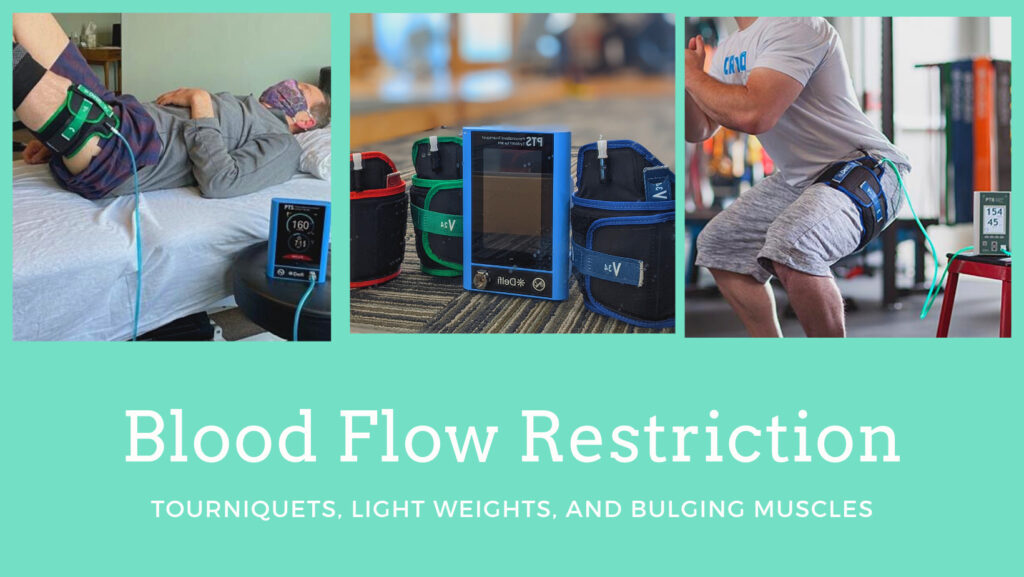Tourniquets, Light Weights and Bulging Muscles; Introducing Personalized Blood Flow Restriction Training at Stride Physio

By Susanne Michaud
Stronger, faster, more powerful than a speeding bullet… That super hero image is the implied outcome of great strength training. To get there, one must consistently lift, push, and pull heavy loads over a period of months. For example, if the most I could dead lift is 100 pounds 1 time, then my dead lifting workouts would be 65 pounds with multiple repetitions. That is the normal formula to become Super(hu)man.
The only problem with that formula is not all joints and tissues can tolerate the heavy loads required to bulk up muscles. People with arthritic joints or recovering from injuries and surgeries must start with significantly lighter loads, making the time and grit it takes to achieve these superhuman results out of reach for many. That’s where Blood Flow Restriction (BFR) training comes in.
What is BFR?
Blood Flow Restriction (BFR) is the use of an automated tourniquet system on the upper part of the arm(s) or leg(s), partially restricting the flow of blood in order to stimulate the growth of muscles. This technique originated in Japan in the 1960’s by Dr. Yoshiaki Sato, known as “KAATSU training”, meaning training with added pressure. The technique gained popularity at military hospitals where it provided benefit to soldiers who had significant limb damage and/or amputations.
Extensive research on BFR training has repeatedly shown that a person who cannot tolerate heavy loads, can get stronger and increase their muscle size faster than those using light weights alone. The BFR groups also get as strong as those who do heavy weightlifting without the risk of muscle damage and pain.
How does BFR work?
By reducing the amount of blood flow in the limb for a limited time while exercising, muscles are tricked into believing they are working harder despite the lighter loads. This is because the muscles are working in an environment with low to no oxygen which stimulates a cellular cascade of events that lead to muscle hypertrophy, bone growth, improved oxygen uptake, and reduced scar formation. This in turn facilitates tissue healing, reduces pain, and improves motor learning and balance control. Check out the sites below for more information!
What are the benefits of BFR?
- Improved muscle growth and strength
- Improved athletic performance
- Improved cardiovascular endurance (VO2 Max)
- Reduced muscle soreness compared with normal strength training
- Increased collagen and protein synthesis
- Increased tendon thickness and stiffness
Who can benefit from BFR?
Stimulation of muscle growth with BFR is proven effective in the elderly, professional and amateur athletes, and in those with chronic musculoskeletal issues. BFR training is indicated for anyone who cannot tolerate lifting heavy loads, whether injured, frail, post-operative or simply out of shape.
What conditions can be treated with BFR?
- Joint replacements
- Osteoarthritis
- ACL repairs
- Rotator cuff injuries
- Achilles tendonitis
- Golfers and tennis elbows
- Fractured bones
- Generalized weakness and deconditioning
What happens in a BFR training?
A wide band cuff is applied to the upper part of the limb. The individuals’ arterial and venous vessel pressure is measured by the automated inflation of the cuff. The pneumatic system has a built in doppler that calibrates to a person’s individualized pressure. This ensures that each person is exercising at the correct pressure for them – not too high (possible tissue damage), not too low (ineffective), just right. Using a calibrated system with a wide cuff is optimal as it reduces one’s risk of injury or excessive pressure. Once a personalized measurement is obtained, the cuff inflates to a lower percentage (40-80%) and the person does a low load exercise (20-30% of 1 rep max), doing 4 sets with rest breaks. For best strength results, it’s recommended to do this 2-4x per week for at least 3 consecutive weeks.
Is BFR safe
Yes, it’s proven safe when administered correctly in clinical settings. Your therapist will screen you to make sure you’re a good candidate for the procedure, as some health conditions warrant greater precautions or are outright contraindicated. High load exercise is never used with BFR as it can increase a person’s risk for muscle damage and oxidative stress. Delayed onset muscle soreness (DOMS) could possibly occur using this technique, but this usually subsides in 24-72 hours. With BFR you work less, have fewer side effects and return quicker to the activities you love to do.
Ask your physical therapist at Stride Physio if this would be a good technique to use during your treatment.
By Susanne Michaud DPT, OCS
